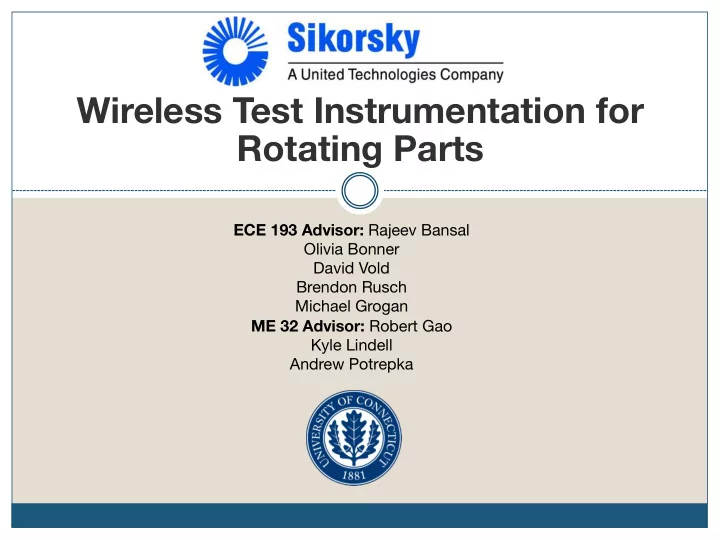

Wireless Test Instrumentation for Rotating Parts ECE 193 Advisor: Rajeev Bansal Olivia Bonner David Vold Brendon Rusch Michael Grogan ME 32 Advisor: Robert Gao Kyle Lindell Andrew Potrepka
Sikorsky Contacts • Company Advisor: Paul Inguanti pinguanti@sikorsky.com • Senior Test Engineer: Chris Winslow cwinslow@sikorsky.com • Test Instrumentation Engineer: Daniel Messner daniel.messner@sikorsky.com
Overview 3 Problem Statement Proposed Solution Timeline Setbacks Solutions Testing Risk Updated Timeline and Budget
Problem Statement 4 Wirelessly transmit data from sensors in a rotating compartment ¡ Must fit within 5” length by 1.5” diameter cylindrical compartment ¡ Data from at least two sensors ¡ Range of at least 40 feet ¡ Must be able to operate for at least one year without needing service ¡ Must be able to operate after at least one month of inactivity
Proposed Solution 5 Arduino Nano RN-XV WiFly module (Wi-Fi transceiver) 1000mAh Li-Po battery DC generator with counterweight for energy harvesting
Proposed Solution 6
Setbacks 7 Spatial Concerns ¡ Breakout board for connecting Arduino to Wi-Fly module must be eliminated ¡ Larger geared generator and counterweight are too large 5V logic vs. 3.3V logic incompatible ¡ Some sensors are incompatible with the logic levels used by the Nano.
Spatial Issue 8 Arduino Nano – XBEE WiFly Breakout Board
Solutions 9 Arduino Pro Mini vs. Arduino Nano
Testing 10 Testing sensor functionality (ECE) Battery charging and discharging (ECE) Generator output voltage and noise (ME)
Sensor Testing 11 One of the accelerometers (ADXL362) uses 3.3V digital logic, not compatible Nano’s 5V digital logic ¡ Compatible with Arduino Pro Mini as operating voltage is 3.3V Another accelerometer (ADXL335) was purchased, compatible with Nano ¡ Ratiometric analog voltage output makes simple interface with 5V microcontroller Remaining sensors compatible with Nano
Sensor Testing 12 Sensor Compatibility Overview ADXL362 ADXL335 Electret Temperature Infrared Microphone Sensor Thermometer 3.3V digital Ratiometric 2.7V-5.5V 2.7V-5.5V 3V operating logic analog output operating operating voltage voltage voltage voltage
Battery Testing 13 850mAh and 1000mAh purchased and tested Charging and discharging tested to ensure proper functionality ¡ Will immediately begin testing for 1 month inactivity with dummy load to represent Arduino and Wi-Fly in sleep mode
Battery Testing 14 Discharge Circuit Test
Battery Testing 15 Discharge Analysis
Generator Testing 16 Larger geared generator Unfiltered output outputs 12V at 1200rpm (4v fluctuations) Smaller generator outputs 3V at 1200RPM Testing showed that 66micro-Farad capacitance across generator leads Filtered output (<1v fluctuations) brought noise to an acceptable level
Wireless Communication 17 Connected to a laptop via wifi. RN-XV transmits data from the UART serial port. Currently can receive commands wirelessly to start sampling and sending data from a few sensors. Eventually able to enter and exit sleep/low power modes via remote command.
Wireless Accelerometer Sampling 18
Upcoming Testing 19 Connect Wi-Fly Module to Arduino without break out board Order layout of components and decide whether to use existing capsule Verification of wireless signal ¡ Transmit a known signal and compare transmitted signal to original
Worst Case Scenarios 20 (1) System: two sensors, energy harvesting, without fulfilling spatial restrictions (2) System: fulfill spatial requirements, 2 or more sensors, without energy harvesting system or su ffi cient battery life ¡ Connect battery cells in parallel to extend battery life
Team Timeline 21
Budget 22 Part ¡ Cost ¡ Switching circuit demo board ¡ $ 75.00 ¡ Li-Po Chargers ¡ $ 96.70 ¡ Battery Connectors ¡ $ 19.00 ¡ Batteries and Generators ¡ $ 142.70 ¡ Electronics Package ¡ $ 287.97 ¡ Wi-Fly Module ¡ $ 24.95 ¡ Total Cost ¡ $ 646.32 ¡
Questions? 23
Recommend
More recommend